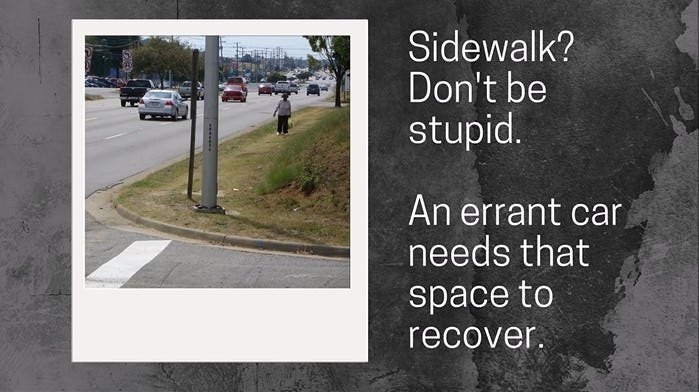The video above is from a series I made in 2015, and it’s just as relevant today.
A clear zone sounds like a military term for an area where you don’t have to be on high alert. A place to safely move and park tanks. It’s true, in a sense. If you’re behind the wheel of an automobile, driving through large clear zones is pretty great.
When you’re driving down the street, the clear zone is the area off to the side where we keep squishy things like people walking or babies in strollers or pets. They all belong in the clear zone.
The Roadside Design Guide defines a clear zone as the total roadside border area, starting at the edge of the traveled way, available for safe use by errant vehicles. This area may consist of a shoulder, a recoverable slope, a non-recoverable slope, and/or a clear run-out area. The desired minimum width is dependent upon traffic volumes and speeds and on the roadside geometry. Simply stated, it is an unobstructed, relatively flat area beyond the edge of the traveled way that allows a driver to stop safely or regain control of a vehicle that leaves the traveled way.
The total roadside area available for safe use by errant vehicles. That’s technical jargon meaning “where a vehicle can swerve and not crash into a tree or a pole or something.” If a driver loses control of their vehicle, they can swerve around and only hit squishy things.
You need to care about your clear zone. It's something that a professional will just go to a manual and pick a value without understanding the street context. The manual will tell them the clear zone needs to be however-many-feet wide based on the functional classification of the streets (its hierarchy on the importance scale).
What happens is that a sidewalk might be there, or somebody's front yard might be there, or a building might be within the clear zone.
Now here's a very important detail from FHWA that a lot of professionals choose to ignore: the clear zone is not a controlling criterion. In other words, it’s not absolute and shouldn’t set the framework for street design. A huge clear zone does not necessarily indicate a safe street.
Sometimes a clear zone can make a safer street. Those are called interstates. But when you're driving through your neighborhood, when you're driving to the store, when you're dropping your kids off at school—you know, driving to all these nearby places because we built stuff that we can't walk on—you don't need huge clear zones. The streets there should be designed for slower driving, and you should expect to see people (squishy things) all around you.
Don't let professionals bully you with a clear zone. Take a look at your surroundings with unprofessional eyes. If you see a community street, if you see an urbanized area, then you know cars do not need to be driving at 50 or 60 mph with an enormous clear zone. Stand firm on this.







